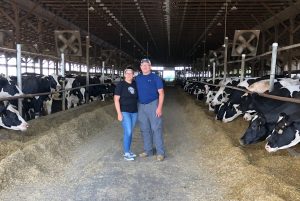
Duane Hershey Is Featured in Special June Dairy Month Podcast Episode
In honor of June Dairy Month and the national recognition around Pennsylvania’s dairy genetics happening this month, the Center for Dairy Excellence interviewed Holstein breeder Duane Hershey from Ar-Joy Farms in Chester County, Pennsylvania, about genomics in the eighth episode of the “Cow-Side Conversations” podcast. Hershey shared how he uses genomic testing to strengthen the performance and longevity of his 725-cow herd.
Hershey opened the podcast by describing the history of his dairy farm and how he discovered his interest in genomics.
“I was always intrigued by the registered Holstein business. It was just intriguing to me that a small dairy somewhere in the United States could breed a cow or a bull that could have an influence on the whole breed. Just the idea that it could happen always made me want to breed a better cow,” he said.
After Hershey and his wife Marilyn took over the farm in the late 1990s, they expanded the dairy in 2001 from a tie-stall barn to a free-stall parlor operation. He found he had to breed cows differently in the free-stall barn compared to the tie stall and shared that he needed the cows to be wider and make as much milk as possible. According to Hershey, genomics played a big part in these types of decisions for his breeding program.
“Before genomics came along, we would purchase the best semen we could find to use on our best cow. In two to three years, we would find out if we made a good decision when that cow started milking,” he explained. “With genomics, it seems like that waiting period got taken out. You can speed up the process on what is important to you for your breeding program.”
For Hershey, his strategy involves only performing genomic tests on approximately 10-20% of the cows that he thinks are genetically superior cow families. He uses net merit to track the genetically superior animals and purchases a limited number of females to be in the embryo transfer program that are superior to the females he currently has in his herd.
“In addition to that, we also purchase some high genetic embryos,” Hershey said in the podcast. “If we’re going to continue to do this, I feel like I have to have a base of recipients that I can use for embryo transfer while the genetically superior animals are born and tested to decide which ones we want to continue to work with.”
Hershey also shared that he cross breeds the bottom 25 percent of his herd to beef to help ensure he does not have more heifers than cows.
“With the increase of reproduction efficiencies and a larger herd, all of a sudden we had more heifers than we needed,” he shared. “That was not a good thing. My banker didn’t appreciate it. So we started working at the other direction and cross breeding with beef to the lower-end cows.”
By using genomic results, Hershey has been able to fine tune key indicators in his breeding program. Throughout the podcast, he discussed the following indicators that are important to his herd:
- Somatic cell count: “The genomic results are going to tell you exactly what the somatic cell score is on that heifer. For me, I think the somatic cell is the most important thing that I use. We have so many bulls we can use, and for me personally, I try really hard not to use anything over about a 2.9 on somatic cell. If you’re going to drive your somatic cell down in your herd, bulls that are about 3 and above are not going to help you. We want to stay strong and positive on milk,” Hershey said.
- Rump angle and teat placement
- Straight legs
- Feed efficiency: “Feed efficiency is a new trait that’s going to become more important, and it will factor into the net merit calculation. Genomics are going to play a part in all the things that are happening today, including this whole carbon footprint climate neutral initiative. Wouldn’t we all want to breed the kind of cow that’s most efficient with every pound of feed that she eats? That’s probably the next trait I’m paying closer attention to,” he added.
With all of his genomic testing efforts, Hershey said the GTPI average of his herd has gone up. He also shared that genomics bring a strong return on investment for his dairy operation.
“The way I look at the investment, if I sell one bull into AI, that paid for all my testing on everything I did this year. If I sell one heifer at a high-profile consignment sale, or sell a group of five to ten embryos, that more than pays for the investment we have in genomic testing,” he said.
As he concluded the podcast, Hershey reminded listeners that genomics may have helped him work toward his unique goals, but every dairy has different priorities.
“What’s important to me may not be important to the next guy down the road. For him, type might be more important. He might show or want to sell offspring for 4-H projects. That’s okay,” he shared. “Genomics provides such a broad area for what’s important to different dairy farmers. Latch on to what’s important to you, and try to take your herd where you want it to go.”
To listen to the full podcast interview, visit www.centerfordairyexcellence.org/podcast. The podcast is also available on Spotify, Apple Podcasts, and Amazon Music. With a new episode released each month, Hershey’s interview is the eighth in the series. The podcast was designed to share real-time farmer insight, tricks of the trade, and inspiring stories from dairies across Pennsylvania.

